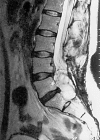Intraoperative urodynamics in spinal cord surgery: a study of feasibility
- PMID: 14634852
- PMCID: PMC3468037
- DOI: 10.1007/s00586-003-0619-7
Intraoperative urodynamics in spinal cord surgery: a study of feasibility
Abstract
Intraoperative monitoring (IOM) of bladder function in spinal cord surgery is a challenging task due to vegetative influences, multilevel innervation and numerous supraspinal modulating factors. Despite routine use of urodynamics in neurosurgery for implantation of bladder stimulators or denervation of nerve fibres in spastic reflex bladders, application of IOM in patients with spinal cord tumours or tethered-cord syndrome is not widespread. Combining urodynamics with sphincter electromyography (EMG) in IOM enables identification of bladder efferents responsible for contraction and continence. We monitored four patients with ependymoma of the Cauda equina, one patient with tethered-cord syndrome and two patients with cervical intramedullary tumours. In all patients undergoing operations of the Cauda equina, identification of bladder efferents responsible for detrusor contraction was possible. There was good correlation between preoperative bladder dysfunction, preoperative urodynamics and intraoperative pressure increase by bladder contraction or latency between stimulation and contraction. This method proved unsuitable for intramedullary tumours where no contraction of the bladder could be observed while stimulating the spinal cord. Intraoperative monitoring of urodynamics is an effective tool for identifying bladder efferents in the Cauda equina. Intraoperative conclusions on bladder dysfunction through registration of pressure increase and latency are possible.
Figures



References
Publication types
MeSH terms
LinkOut - more resources
Full Text Sources

